This article was co-authored by Tu Anh Vu, DMD. Dr. Tu Anh Vu is a board certified dentist who runs her private practice, Tu's Dental, in Brooklyn, New York. Dr. Vu helps adults and kids of all ages get over their anxiety with dental phobia. Dr. Vu has conducted research related to finding the cure for Kaposi Sarcoma cancer and has presented her research at the Hinman Meeting in Memphis. She received her undergraduate degree from Bryn Mawr College and a DMD from the University of Pennsylvania School of Dental Medicine.
There are 11 references cited in this article, which can be found at the bottom of the page.
wikiHow marks an article as reader-approved once it receives enough positive feedback. This article received 20 testimonials and 87% of readers who voted found it helpful, earning it our reader-approved status.
This article has been viewed 1,784,366 times.
Brushing your teeth is not just for a whiter smile and fresher breath, it's critical for your overall health.[1] When you brush, you remove plaque — a thin film of bacteria that sticks to your teeth and will create cavities, gum disease, and if you ignore it long enough, will cause your teeth to fall out! You know why to brush, but if you would like to learn how to brush your teeth efficiently, these suggestions will help.
Steps
Using the Right Tools
-
1Use a good toothbrush. Choose a toothbrush with soft nylon bristles.[2] This must effectively remove plaque and debris from your teeth, without irritating the gums or eroding tooth enamel like hard-bristled brushes can do when used with sideways action. The toothbrush should also fit comfortably in your hand, and have a head small enough to easily reach all of your teeth, especially the ones at the back. If you have difficulty fitting the toothbrush into your mouth, it is probably too big.[3]
- Electric toothbrushes are a great choice if you are a lazy brusher and think that the electric toothbrush might encourage you to spend more time on your teeth; however, you can do just as good of a job with a manual toothbrush — it's all in the technique.[4]
- One good method is to brush with a manual toothbrush in the morning and use an electric toothbrush at night.
- You should avoid toothbrushes with "natural" bristles made from animal hair as these can harbor bacteria and must be replaced more frequently.
-
2Replace your toothbrush regularly. The bristles will wear out over time, losing their flexibility and effectiveness. You should purchase a new toothbrush every three to four months, or as soon as the bristles start to splay and lose their shape. Visual inspection of the toothbrush is more important than the actual timeline. You can also buy toothbrushes whose handles will change color when it's time to purchase a new toothbrush.
- Research has found that thousands of microbes call toothbrush bristles and handles "home," and can cause infections.
- At about three months, bristles become sharp due to friction and can cause your gums to bleed.
- Always rinse your brush after using it, and store it upright and uncovered so that it can dry before your next use. Otherwise bacteria will grow.[5]
Advertisement -
3Use fluoride toothpaste.[6] It not only helps remove plaque, but it also helps strengthen tooth enamel. It's important to note that fluoride toothpaste is not to be swallowed, as ingesting too much can have serious health consequences. It should not be used for children under the age of three.[7]
- You can get toothpaste to target a wide variety of dental and gum problems, including cavities, tartar, sensitive teeth and gums, gingivitis and stained teeth. Opt for the one that suits your best or ask your dentist or hygienist for advice.[8]
-
4Use dental floss.[9] Flossing your teeth is just as important as brushing, as it removes built-up plaque, bacteria and food particles that get trapped between the teeth, which soft floppy toothbrush bristles can't reach even when used with up/down natural motion. You should always floss before brushing your teeth so that any food or bacteria that comes loose during flossing doesn't remain in your mouth.
- Remember to floss gently. Don't "snap" the floss between the teeth as this can irritate sensitive gums. Ease it down gently, following the curve of each tooth.
- If you find dental floss awkward to use, or you have braces, look for dental picks instead. These are small wooden or plastic sticks that you can insert between teeth, achieving the same results as flossing if spaces are large enough.
- Alternatively, you can use flossers, which are small pieces of floss strung between 2 supports, generally with a pick at the opposite end.
Mastering the Brushing Technique
-
1Use a small amount of toothpaste. Squeeze only a pea-sized amount of toothpaste onto your toothbrush. Applying too much toothpaste can cause over-sudsing, tempting you to spit and finish too early. Plus, it increases the risk of you ingesting more fluoride-filled toothpaste, which is very unhealthy. [10]
- If brushing is painful, try brushing more gently with accurate circle motion only or switch to a toothpaste formulated for sensitive teeth.
-
2Set your bristles at the gum line at a 45-degree angle. Gently brush with a short, circular motion. Don't brush across your teeth.[11] Ask your dentist or hygienist to present you the correct brushing technique.
-
3Spend two to three minutes brushing.[12] Brush just a few teeth at a time, and work your way around your mouth in a circle so that you get every tooth (spend about 12 to 15 seconds in each spot). If it helps, you can divide your mouth into quadrants: top left, top right, bottom left, and bottom right. If you spend 30 seconds on each quadrant, you'll get a full two minutes of brushing time in.
- Try starting at the outside lower left teeth, moving to the outside lower right, then outside upper right to the upper left. Change to inside uppers and brush inside upper right, inside lower right, and finally inside lower left.
- If you get bored, try brushing your teeth while watching television or hum a song to yourself while you brush. Brushing your teeth for the duration of an entire song will ensure that you brush thoroughly!
-
4Brush your molars.[13] Position the toothbrush so that it's perpendicular to your lips, or so that the bristles are resting on top of your bottom molars. Work the toothbrush in an in-and-out motion, and move from the back of your mouth to the front. Then complete this motion doing a rotational movement of the brush in order to eliminate bacteria that have been dislocated from the surface. Repeat on the other side of your mouth. When the bottom teeth are clean, flip the toothbrush over and work on the top molars.
- To access outside top molars always swing the lower jaw to the side you are working on. This will increase the space available to move your brush up and down by several times so that no sideways motion occurs.
-
5Brush the inner surfaces of your teeth. Tip the toothbrush so that the head of the toothbrush is pointing towards your gum line, and brush each tooth. Dentists report that the most commonly skipped area is the inside of the lower front teeth, so be sure not to forget those! Check that your mouth is opening wide enough by holding teeth apart with two or three fingers of your other hand. This will allow correct vertical angle to reach edge of gum.[14]
-
6Brush your tongue gently. After you've cleaned your teeth, use the bristles of your toothbrush to gently clean your tongue. (Don't press too hard, or you'll damage the tissue.) This helps keep bad breath away and gets rid of bacteria on your tongue.
Finishing Up
-
1Rinse out your mouth. If you choose to rinse after brushing, take a sip of water from a disposable cup, or cup your hands under the faucet. Swish it around your mouth, and spit it out.
- Note that there is some debate on whether or not this is recommended. While some feel that it reduces the efficacy of the topical fluoride treatment, others wish to ensure that no fluoride is ingested. There are also those who just don't like having toothpaste in their mouths! If you're at high risk of getting cavities, it may be beneficial not to rinse, or rinse with just a small amount of water — effectively creating a fluoride mouthwash.[15]
- Other studies have shown that rinsing after brushing has no significant impact on the effectiveness of brushing with a fluoride toothpaste.[16]
-
2Rinse your toothbrush. Hold your toothbrush under running water for a few seconds to remove any bacteria from the brush. If you don't rinse the toothbrush properly, you can actually introduce old bacteria into your mouth the next time you use it. Rinsing also removes any leftover toothpaste. Place your toothbrush somewhere where it will readily dry out. Otherwise, bacteria can grow.
-
3Finish with a fluoride-based mouthwash (Optional). Take a small sip of mouthwash, swish it in your mouth for about 30 seconds, and spit it out. Be careful not to swallow any.
-
4Rinse your mouth with salt water (Optional). Saltwater kills the bad bacteria on your teeth. There is a rumor that saltwater is acidic and can erode teeth if used too often. However, it's better not to use it too often.
- For complete antibacterial protection rinse with a chlorhexidine mouthwash before going to bed, but do not use it for longer than two weeks in a row.
-
5Remember to brush at least twice a day. Most dentists recommend that you brush at least twice a day — once in the morning and once before bed. If you can fit in a third time somewhere in the middle, even better! Try brushing at a 45° angle as this helps remove plaque and food/drink particles on your teeth better than if you did it normally. You should also try to avoid snacking between meals as much as possible, as this results in more food debris and bacteria building up in the mouth.EXPERT TIPDr. Joseph Whitehouse is a board certified Dentist and the Former President of the World Congress on Minimally Invasive Dentistry (WCMID). Based in Castro Valley, California, Dr. Whitehouse has over 46 years of dental experience and counseling experience. He has held fellowships with the International Congress of Oral Implantology and with the WCMID. Published over 20 times in medical journals, Dr. Whitehouse's research is focused on mitigating fear and apprehension patients associate with dental care. Dr. Whitehouse earned a DDS from the University of Iowa in 1970. He also earned an MA in Counseling Psychology from California State University Hayward in 1988.Board Certified Dentist

 Joseph Whitehouse, MA, DDS
Joseph Whitehouse, MA, DDS
Board Certified DentistExpert Trick: If you have a regular dentist that you see, ask them if they notice any problem areas the next time you have an appointment. Your dentist can give you specific advice about places you might be missing when you brush.
Expert Q&A
Did you know you can get expert answers for this article?
Unlock expert answers by supporting wikiHow
-
QuestionWhat kind of toothbrush recommended?
 Cristian Macau, DDSDr. Macau is an oral surgeon, periodontist, and aesthetician at Favero Dental Clinic in London. He received his DDS from Carol Davila University of Medicine in 2015.
Cristian Macau, DDSDr. Macau is an oral surgeon, periodontist, and aesthetician at Favero Dental Clinic in London. He received his DDS from Carol Davila University of Medicine in 2015.
Doctor of Dental Surgery
-
QuestionDon't you have to use a tongue cleaner?
 Cristian Macau, DDSDr. Macau is an oral surgeon, periodontist, and aesthetician at Favero Dental Clinic in London. He received his DDS from Carol Davila University of Medicine in 2015.
Cristian Macau, DDSDr. Macau is an oral surgeon, periodontist, and aesthetician at Favero Dental Clinic in London. He received his DDS from Carol Davila University of Medicine in 2015.
Doctor of Dental Surgery
Warnings
- Don't brush too hard. Gums are very sensitive tissue.⧼thumbs_response⧽
- Do not swallow toothpaste or mouthwash. They contain chemicals that are toxic if you swallow them, e.g. ammonia and cetylpyridinium chloride.⧼thumbs_response⧽
- Never use someone else's toothbrush. You can transfer germs, bacteria, and diseases through microscopic cuts in your mouth.⧼thumbs_response⧽
- Bleeding from infected areas may be expected to occur for a few days followed by rapid healing to the healthy mouth you deserve.⧼thumbs_response⧽
- Do not skip brushing your teeth — skipping out on this vital practice can cause tooth decay.⧼thumbs_response⧽
- Wait at least 45 minutes before brushing your teeth after drinking soda, wine, or acidic juices such as orange juice. Sodas and juices leave residual acids on the teeth, and brushing can actually damage the enamel.[18]⧼thumbs_response⧽
Things You'll Need
- Floss
- Toothbrush
- Toothpaste
- Water
- Saltwater (Optional)
- Mouthwash (optional)
References
- ↑ http://www.webmd.com/oral-health/news/20100527/brushing-teeth-may-keep-heart-disease-away
- ↑ Tu Anh Vu, DMD. Board Certified Dentist. Expert Interview. 10 April 2020.
- ↑ http://www.webmd.com/oral-health/healthy-teeth-10/brushing-teeth-mistakes
- ↑ Tu Anh Vu, DMD. Board Certified Dentist. Expert Interview. 10 April 2020.
- ↑ http://www.mayoclinic.com/health/dental/DE00003
- ↑ Tu Anh Vu, DMD. Board Certified Dentist. Expert Interview. 10 April 2020.
- ↑ http://www.fluoridealert.org/issues/dental-products/toothpastes/
- ↑ http://www.colgate.com/app/CP/US/EN/OC/Information/Articles/Oral-and-Dental-Health-Basics/Oral-Hygiene/Brushing-and-Flossing/article/How-to-Brush.cvsp
- ↑ Tu Anh Vu, DMD. Board Certified Dentist. Expert Interview. 10 April 2020.
- ↑ http://blog.juliegillisdds.com/?p=47
- ↑ http://www.webmd.com/oral-health/healthy-teeth-10/brushing-teeth-mistakes?page=2
- ↑ Tu Anh Vu, DMD. Board Certified Dentist. Expert Interview. 10 April 2020.
- ↑ Tu Anh Vu, DMD. Board Certified Dentist. Expert Interview. 10 April 2020.
- ↑ http://www.webmd.com/oral-health/healthy-teeth-10/brushing-teeth-mistakes?page=2
- ↑ http://www.ncbi.nlm.nih.gov/pubmed/8281561
- ↑ http://www.ncbi.nlm.nih.gov/pubmed/12399689
- ↑ http://www.webmd.com/oral-health/healthy-teeth-10/brushing-teeth-mistakes?page=1
- ↑ http://www.mayoclinic.com/health/brushing-your-teeth/AN02098
About This Article
To brush your teeth properly, use a light-bristled toothbrush and fluoride toothpaste. Start brushing by placing your toothbrush on your front teeth at a 45-degree angle. Then, brush each tooth in a circular motion for 3-5 seconds. Once you’ve finished brushing your front teeth, move on to your molars, then brush the back of your teeth. Finally, softly brush your tongue to get rid of bad breath and plaque. It should take you about 2-3 minutes to brush your whole mouth. Brushing for 2 minutes twice a day helps to remove plaque and keep your teeth healthy for years to come! For more tips from our Dental co-author, including how to find the right toothbrush for you, read on!

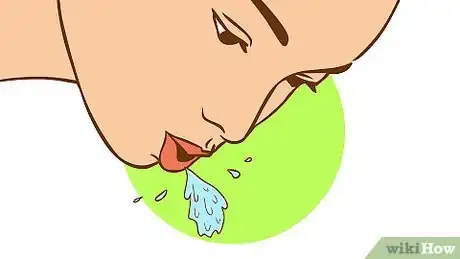
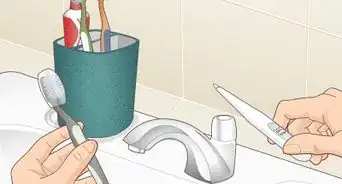

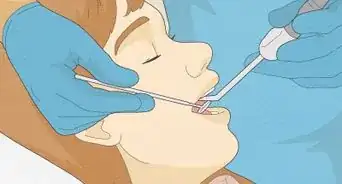
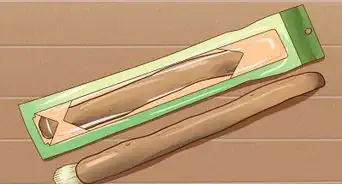
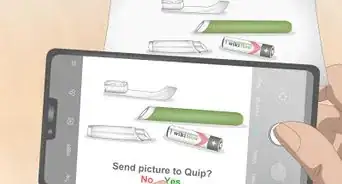
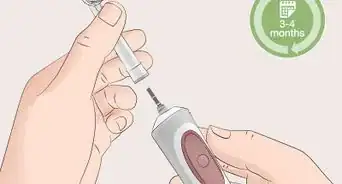
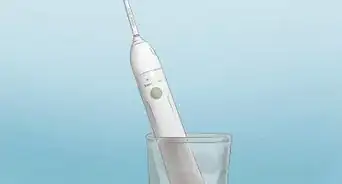
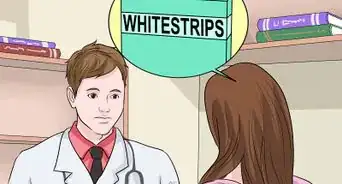
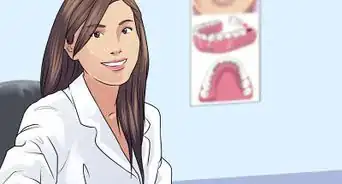
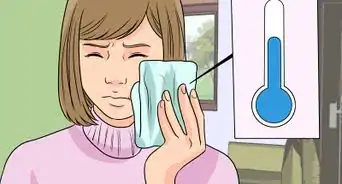

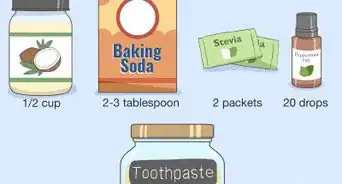
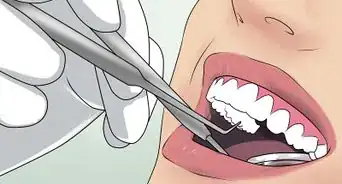
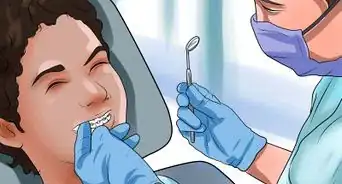












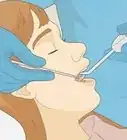
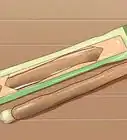



































Medical Disclaimer
The content of this article is not intended to be a substitute for professional medical advice, examination, diagnosis, or treatment. You should always contact your doctor or other qualified healthcare professional before starting, changing, or stopping any kind of health treatment.
Read More...